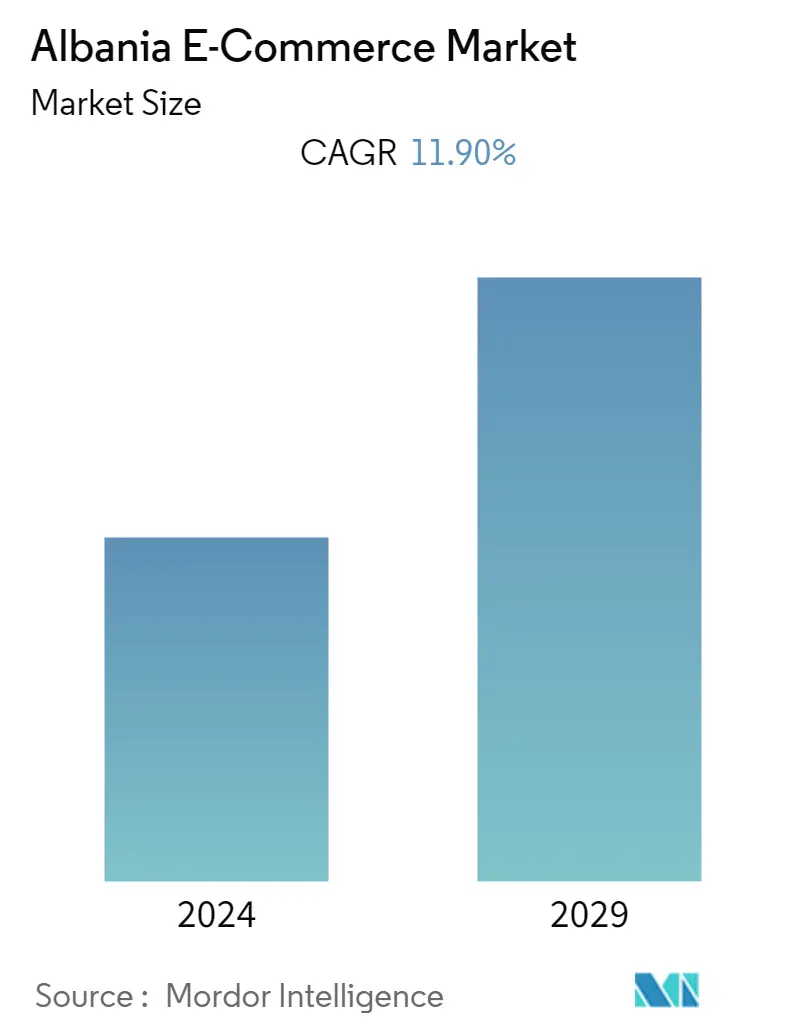Market Size of Albania E-Commerce Industry

| Study Period | 2019 - 2029 |
| Base Year For Estimation | 2023 |
| Forecast Data Period | 2024 - 2029 |
| Historical Data Period | 2019 - 2022 |
| CAGR | 11.90 % |
| Market Concentration | Medium |
Major Players
*Disclaimer: Major Players sorted in no particular order |
Albania E-commerce Market Analysis
In Albania, e-commerce is still in its infancy stage. Domestic retailers are increasingly adopting online shopping, and the number of Internet users has increased significantly in recent years, again boosted by COVID-19, but Albanian shoppers generally visit stores. Also, the use of electronic payments is rare. The market is expected to grow at a CAGR of 11.9% during the forecast period (2022 - 2027).
- Albania is primarily a cash economy and is a major impediment to the development of faster e-commerce. Cross-border electronic shopping is still in its infancy due to low credit card usage, low purchasing power, and high shipping costs. In addition, many foreign online retailers do not ship to Albania or charge exorbitantly high shipping costs.
- According to the International Trade administration, e-commerce in Albania is offered by a limited number of domestic merchants. Credit card usage is increasing, but it is restricted except in large hotels, restaurants, and department stores. The use of mobile phones to pay for goods and services is underdeveloped but not widespread. Currently, mobile phone use is limited to mobile banking. Businesses primarily use it, but it is only used to pay for utilities in a limited pool of individual users.
- In Albania, digital trade seems to have entered a "golden" phase since few years. Businesses are seeing it as a manner to "disconnect" purchasers from the conventional approaches of acquiring, to insert the digital world, to provide the whole lot in actual time and quickly. It is visible as a reaction to the financial disaster to acquire services and products cost-free. Even legislation ,which has currently passed through changes, has "opened" the gates to those services.
- The government has implemented significant reforms to promote trade and encourage foreign direct investment, including administrative procedures, customs, business registration, licenses, tax payments, e-services, etc. However, significant challenges remain despite recent improvements, such as Albania's infrastructure, which requires further investment and development.
- The COVID-19 pandemic disrupted global trade, supply chains, and labor markets, curtailed consumption and investment, and slowed global economic activity. This significantly impacted the UNECE region, including the transitional countries. Border closures and partial or complete blockades have become new norms in many parts of the world. The transition economy in the UNECE region, which is the focus of attention here, has been hit hard by the recession caused by the pandemic. These economies are Albania, Armenia, Azerbaijan, and Belarus.
Albania E-commerce Industry Segmentation
E-commerce is a cross-industry sales channel that sells or promotes brand awareness online, is considered a sales channel, and is part of a company's digital strategy. Business-to-business (B2B) e-commerce transactions occur between companies sold in bulk by the supplier. Business to Consumer (B2C) means that a company sells its products to its customers directly from its website or online marketplace. A set of software technologies built into a company's website. This allows companies to request products and services from their websites and complete the sales cycle. The studied market will investigate the impact of e-commerce on Albania, provide the various trends, drivers and challenges faced in the country, and provides information on major domestic companies that innovate new solutions in the ecommerce market.
Albania E-Commerce Market Size Summary
The Albanian e-commerce market is in the early stages of development, with domestic retailers gradually embracing online shopping. The increase in internet users, accelerated by the COVID-19 pandemic, has not yet translated into widespread adoption of electronic payments, as Albania remains predominantly a cash-based economy. Despite these challenges, the market is poised for growth, driven by reforms aimed at promoting trade and attracting foreign investment. The government's efforts to improve administrative procedures and digital services are crucial in overcoming infrastructural hurdles and enhancing the e-commerce landscape. The pandemic's impact on global trade has highlighted the importance of digital channels, prompting businesses to explore e-commerce as a means to reach broader markets and improve competitiveness.
Albania's e-commerce sector is witnessing a shift as businesses leverage digital platforms to enhance visibility and streamline operations. The consumer electronics sector, in particular, has seen significant advancements, with major retailers establishing online stores to complement their physical presence. While broadband access is improving, rural areas still face connectivity challenges, necessitating combined efforts from both private and public sectors to address these issues. The tourism and business process outsourcing sectors are also embracing online solutions to attract customers and streamline operations. Financial inclusion and the expansion of digital financial services are critical for the growth of e-commerce, as reliance on cash for delivery poses risks and increases costs. Initiatives to boost internet accessibility, simplify online payments, and build consumer confidence through awareness campaigns and consumer protection frameworks are essential for leveraging the potential of e-commerce in Albania.
Albania E-Commerce Market Size - Table of Contents
-
1. MARKET INSIGHTS
-
1.1 Market Overview
-
1.2 Industry Attractiveness-Porter's Five Force Analysis
-
1.2.1 Bargaining Power of Suppliers
-
1.2.2 Bargaining Power of Buyers/Consumers
-
1.2.3 Threat of New Entrants
-
1.2.4 Threat of Substitute Products
-
1.2.5 Intensity of Competitive Rivalry
-
-
1.3 Key market trends and share of e-commerce of total Retail sector
-
1.4 Impact of COVID-19 on the e-commerce sales
-
-
2. Market Segmentation
-
2.1 By B2C ecommerce
-
2.1.1 Market size (GMV) for the period of 2017-2027
-
2.1.2 Market Segmentation - by Application
-
2.1.2.1 Beauty & Personal Care
-
2.1.2.2 Consumer Electronics
-
2.1.2.3 Fashion & Apparel
-
2.1.2.4 Food & Beverage
-
2.1.2.5 Furniture & Home
-
2.1.2.6 Others (Toys, DIY, Media, etc.)
-
-
-
2.2 By B2B ecommerce
-
2.2.1 Market size for the period of 2017-2027
-
-
Albania E-Commerce Market Size FAQs
What is the current Albania E-Commerce Market size?
The Albania E-Commerce Market is projected to register a CAGR of 11.90% during the forecast period (2024-2029)
Who are the key players in Albania E-Commerce Market?
Bufalo, Celestino, Neptun, Care to beauty and Siren are the major companies operating in the Albania E-Commerce Market.

